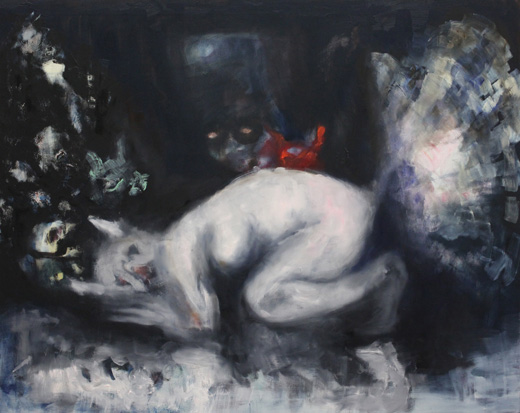
Emeli Theander
Bleirauch
STUTTGART: 6. Juni - 30. Juli 2011

In den Bildern und Skulpturen Emeli Theander verliert die konkrete äußere Welt an Faszination gegenüber der Welt des Subjekts. Die Wahrheit des Subjekts hat immer den Charakter einer Fiktion. Sie ist eine symbolische Konstruktion aus heterogenen Elementen, in der sich Zeugnisse, Zitate und Deutungen des Subjekts mischen. Damit ist die Fiktion jedoch keine bloß „subjektive“ oder „relative“ Wahrheit, sondern sie ist in erster Linie ein Wirken.
Die ambivalente Wirkmacht von Albträumen, Visionen, oftmals des Grauens, verspricht ein poetisches Potential zwischen Angst und Lust, das die Kunst seit jeher beflügelt. Anhand der „Kunstgeschichte des Grauens“ lässt sich feststellen, dass auch diese andere traumatische Welt jenseits der Grenze einer Ordnung unterworfen ist. Diese „Ordnung des Unbewussten“ in der Kunst ist durch Stilmerkmale gekennzeichnet, die mit dem Begriff des Formlosen (Bois/Krauss) verbunden sind. Gemeint ist hierbei nicht die Negation der Form, sondern vielmehr die Bewegung ihrer Auflösung, der Prozess der Überschreitung oder Penetration von Körpergrenzen.
Emeli Theanders Malerei konkretisiert sich auf der Grenze zwischen dem schönen Schein und dem Unheimlichen fremder Welten. Ihre vergeisterten Wesen in traumhaft düsteren, an Goyas Caprici oder Füsslis Nachtmahr erinnernden Szenerien, lassen auch malerisch dem Flüchtigen, Vagen seinen Raum und geben sich der Lust am Schauer hin. Oftmals sind es kindliche Geschöpfe, die den Betrachter in ihr unschuldig-teuflisches Spiel zu verwickeln und in karnevaleske Welten zu entführen suchen. Text: Galerie Parrotta Contemporary Art.
Emeli Theander »Bleirauch« (Engl.)
In the pictures and sculptures by Emeli Theander, the concrete external world loses its fascination in comparison with the world of the subject. The subject’s truth always bears the character of fiction. It is a symbolic construction out of heterogeneous elements in which evidence, quotes and interpretations of the subject interfuse. In this way, fiction is not solely a “subjective” or “relative” truth but first and foremost an effective force.
The ambivalent effect caused by nightmares, visions, and often horror promises a poetic potential between angst and lust that has been firing art since the early days. On the basis of the “Art History of Horror” one can establish that this other traumatic world beyond borders is subject to an order. Within art, this “Order of the Subconscious” is marked by characteristics of style which are connected to the term of the formless (Bois/Krauss). Here, this does not mean negation of the form but rather the notion of its dissolution, the process of exceeding or penetrating the boundaries of the body.
Emeli Theander’s painting concretizes on the border between the beautiful appearance and the weirdness of strange worlds. Her ghostly creatures in a dreamlike dark scenery reminiscent of Goya’s Caprici or Füssli’s Nightmare leave room for the fleeting and vague indulging in lust for shivers. These creatures are often childlike and they are trying to involve the viewers in their innocent diabolic game and to abduct them to their carnival worlds. Text: Parrotta Contemporary Art Gallery.